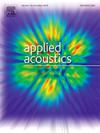An application of a MEMS vector hydrophone for condition assessment of a water supply pipe
IF 3.4
2区 物理与天体物理
Q1 ACOUSTICS
引用次数: 0
Abstract
This paper describes an application of a micro-electromechanical system (MEMS) vector hydrophone to detect 10–20 mm wall damage in a 300 mm diameter ductile iron pipe used for water distribution. A key novelty of this work is the use of the acoustic pressure and particle velocity measured in the vicinity of the pipe wall at frequencies of sound with wavelengths much greater than the pipe diameter, i.e. below 400 Hz. It is shown through numerical simulation and laboratory experiment that the acoustic particle velocity, unlike the acoustic pressure, is highly sensitive to the presence of relatively small wall damage. This work paves the way for the development of new sensor solutions that can be deployed on inspection robots in pressurized clean and wastewater pipes to localize the onset of wall damage. Machine learning algorithms could be used to train the robot to recognize signal patterns associated with an in-pipe defect to guide maintenance and repair equipment.
求助全文
约1分钟内获得全文
求助全文
来源期刊

Applied Acoustics
物理-声学
CiteScore
7.40
自引率
11.80%
发文量
618
审稿时长
7.5 months
期刊介绍:
Since its launch in 1968, Applied Acoustics has been publishing high quality research papers providing state-of-the-art coverage of research findings for engineers and scientists involved in applications of acoustics in the widest sense.
Applied Acoustics looks not only at recent developments in the understanding of acoustics but also at ways of exploiting that understanding. The Journal aims to encourage the exchange of practical experience through publication and in so doing creates a fund of technological information that can be used for solving related problems. The presentation of information in graphical or tabular form is especially encouraged. If a report of a mathematical development is a necessary part of a paper it is important to ensure that it is there only as an integral part of a practical solution to a problem and is supported by data. Applied Acoustics encourages the exchange of practical experience in the following ways: • Complete Papers • Short Technical Notes • Review Articles; and thereby provides a wealth of technological information that can be used to solve related problems.
Manuscripts that address all fields of applications of acoustics ranging from medicine and NDT to the environment and buildings are welcome.
 求助内容:
求助内容: 应助结果提醒方式:
应助结果提醒方式:


